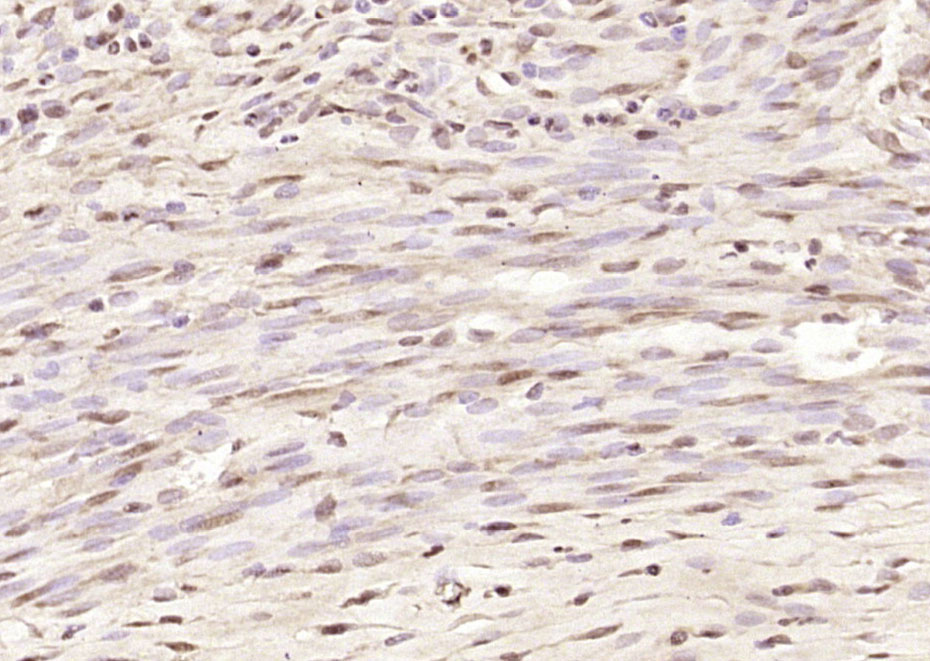
Rabbit Anti-FANCA antibody
FA 1; FA; FA H; FA1; FAA; FACA; FAH; Fanca; FANCA_HUMAN; FANCH; Fanconi anemia complementation group A; Fanconi anemia complementation group H; Fanconi anemia group A protein; Fanconi anemia type 1; MGC75158; Protein FACA.
View History [Clear]
Details
Product Name FANCA Chinese Name 范可尼贫血组蛋白A抗体 Alias FA 1; FA; FA H; FA1; FAA; FACA; FAH; Fanca; FANCA_HUMAN; FANCH; Fanconi anemia complementation group A; Fanconi anemia complementation group H; Fanconi anemia group A protein; Fanconi anemia type 1; MGC75158; Protein FACA. Research Area Cell biology Developmental biology Cyclin Immunogen Species Rabbit Clonality Polyclonal React Species Rat, (predicted: Human, Mouse, Chicken, Rabbit, ) Applications ELISA=1:5000-10000 IHC-P=1:100-500 IHC-F=1:100-500 ICC=1:100-500 IF=1:100-500 (Paraffin sections need antigen repair)
not yet tested in other applications.
optimal dilutions/concentrations should be determined by the end user.Theoretical molecular weight 160kDa Cellular localization The nucleus cytoplasmic Form Liquid Concentration 1mg/ml immunogen KLH conjugated synthetic peptide derived from human FANCA: 461-560/1455 Lsotype IgG Purification affinity purified by Protein A Buffer Solution 0.01M TBS(pH7.4) with 1% BSA, 0.03% Proclin300 and 50% Glycerol. Storage Shipped at 4℃. Store at -20 °C for one year. Avoid repeated freeze/thaw cycles. Attention This product as supplied is intended for research use only, not for use in human, therapeutic or diagnostic applications. PubMed PubMed Product Detail Fanconi anemia (FA) is an autosomal recessive disorder characterized by bone marrow failure, birth defects and chromosomal instability. At the cellular level, FA is characterized by spontaneous chromosomal breakage and a unique hypersensitivity to DNA cross-linking agents. At least eight complementation groups (A-G) have been identified and six FA genes (for subtypes A, C, D2, E, F and G) have been cloned. The FA proteins lack sequence homologies or motifs that could point to a molecular function. The cellular accumulation of FA proteins, including FANCA and FANCG, is subject to regulation by TNF alpha signaling. Phosphorylation of FANC (Fanconi anemia complementation group) proteins is thought to be important for the function of the FA pathway. FANCA, also known as FACA and FANCH, associates with the Brm-related gene 1 (BRG1) product, a subunit of the SWI/SNF complex which remodels chromatin structure through a DNA-dependent ATPase activity. FANCA is mainly expressed in lymphoid tissues, testis and ovary. The amino-terminal region of the FANCA protein is required for FANCG binding, FANCC binding, nuclear localization and functional activity of the complex. The human FANCA gene maps to chromosome 16q24.3 and encodes a 1,455 amino acid protein.
Function:
DNA repair protein that may operate in a postreplication repair or a cell cycle checkpoint function. May be involved in interstrand DNA cross-link repair and in the maintenance of normal chromosome stability
Subunit:
Belongs to the multisubunit FA complex composed of FANCA, FANCB, FANCC, FANCE, FANCF, FANCG, FANCL/PHF9 and FANCM. The complex is not found in FA patients. In complex with FANCF, FANCG and FANCL, but not with FANCC, nor FANCE, interacts with HES1; this interaction may be essential for the stability and nuclear localization of FA core complex proteins. The complex with FANCC and FANCG may also include EIF2AK2 and HSP70. Interacts with FAAP20/C1orf86; interaction is direct.
Subcellular Location:
Nucleus. Cytoplasm. Note=The major form is nuclear. The minor form is cytoplasmic.
Post-translational modifications:
Phosphorylated upon DNA damage, probably by ATM or ATR. Phosphorylation is required for the formation of the nuclear complex. Not phosphorylated in cells derived from groups A, B, C, E, F, G, and H.
DISEASE:
Defects in FANCA are a cause of Fanconi anemia (FA) [MIM:227650]. FA is a genetically heterogeneous, autosomal recessive disorder characterized by progressive pancytopenia, a diverse assortment of congenital malformations, and a predisposition to the development of malignancies. At the cellular level it is associated with hypersensitivity to DNA-damaging agents, chromosomal instability (increased chromosome breakage), and defective DNA repair.
Similarity:
Nucleus. Cytoplasm. The major form is nuclear. The minor form is cytoplasmic.
SWISS:
O15360
Gene ID:
2175
Database links:Entrez Gene: 2175 Human
Entrez Gene: 14087 Mouse
Omim: 607139 Human
SwissProt: O15360 Human
SwissProt: Q9JL70 Mouse
Unigene: 290154 Human
Product Picture
Bought notes(bought amounts latest0)
No one bought this product
User Comment(Total0User Comment Num)
- No comment



 +86 571 56623320
+86 571 56623320
 +86 18668110335
+86 18668110335

